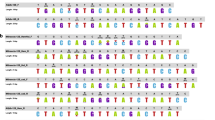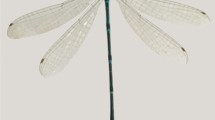Abstract
The genetic structure of the brine shrimp Artemia franciscana, an extremophile halophilic microcrustacean, from the Great Salt Lake (USA), was investigated by analysis of nucleotide sequences of the mitochondrial cytochrome c oxidase subunit I (COI), genomic fingerprinting by ISSR-PCR (inter-simple sequence repeats polymerase chain reaction) and biometry. Samples from six different geographical localities of Great Salt Lake revealed ten distinct haplotypes with a mean high level of haplotype diversity (HD = 0.6). Phylogenetic and genetic fingerprinting analyses supported the null hypothesis, that the brine shrimps of this lake form a panmictic gene pool with a low level of genetic differentiation index (F ST = 0.05) and a high rate of gene flow (Nm = 2.8) between geographical areas. Moreover, morphological parameters revealed no population structure among all examined populations. Neutrality tests and mismatch distribution revealed that A. franciscana has undergone a recent population expansion. In spite of hypersaline conditions in the Northern (Gunnison Bay) regions of the Great Salt Lake, the genetic population structures of different areas of the lake are not linked to ecological or limnological conditions. Therefore, A. franciscana from the Great Salt Lake should be considered as a single management unit for conservation.



Similar content being viewed by others
References
Abatzopoulos TJ, Zhang B, Sorgeloos B (1998) Artemia tibetiana: preliminary characterization of a new Artemia species found in Tibet (People’s Republic of China) International Study on Artemia LIX. Int J Salt Lake Res 7:41–44
Abatzopoulos TJ, Baxevanis AD, Triantaphyllidis GV, Criel G, Pador EL, Van Stappen G, Sorgeloos P (2006) Quality evaluation of Artemia urmiana Günther (Urmia Lake, Iran) with special emphasis on its particular cyst characteristics (International study on Artemia LXIX). Aquaculture 254:442–454
Abatzopoulos TJ, Amat F, Baxevanis AD, Belmonte G, Hontoria F, Maniatsi S, Moscatello S, Mura G, Shadrin NV (2009) Updating geographic distribution of Artemia urmiana Günther, 1890 (Branchiopoda: Anostraca) in Europe: an integrated and interdisciplinary approach. Int Rev Hydrobiol 94:560–579
Aldrich TW, Paul D (2002) Avian ecology of Great Salt Lake. In: Gwynn JW (ed) Great Salt Lake, an overview of change. Special Publication of the Utah Department of Natural Resources, Salt Lake City, pp 343–374
Arnow T, Stephens DW (1990) Hydrologic characteristics of the Great Salt Lake, Utah, 1847–1986. US Geological Survey water-supply paper (U.S.A.), Utah
Asem A, Shi-Chun S (2014) Biometric characterization of chinese parthenogenetic Artemia (Crustacea: Anostraca) cysts, focusing on its relationship with ploidy and habitat altitude. N. West J Zool 10:149–157
Asem A, Rastegar-Pouyani N, Agh N (2007) Biometrical study of Artemia urmiana (Anostraca: Artemiidae) cysts harvested from Lake Urmia (West Azerbaijan, Iran). Turk J Zool 31:2
Bandelt HJ, Forster P, Röhl A (1999) Median-joining networks for inferring intraspecific phylogenies. Mol Biol Evol 16:37–48
Brosius F (2013) SPSS 21. Heidelberg u. a.: mitp. 1. Auflage
Bruggemann E, Sorgeloos P, Vanhaecke P (1980) Persoone G, Sorgeloos P, Roels O, Jaspers E. In: The brine shrimp Artemia, vol 3. Ecology, culturing, use in aquaculture. Universa Press, Wetteren, pp 261–269
Cai Y (1989) A redescription of the brine shrimp (Artemia sinica). Wasmann J Biol 47:105–110
Chiang HC, Hsu CC, Lin HD, Ma GC, Chiang TY, Yang HY (2006) Population structure of bigeye tuna (Thunnus obesus) in the South china sea, philippine sea and western pacific ocean inferred from mitochondrial DNA. Fish Res 79:219–225
Cowen RK, Lwiza KM, Sponaugle S, Paris CB, Olson DB (2000) Connectivity of marine populations: open or closed? Science 287:857–859
Dasmahapatra K, Lacy R, Amos W (2008) Estimating levels of inbreeding using AFLP markers. Heredity 100:286–295
Eimanifar A, Mohebbi F (2007) Urmia Lake (northwest Iran): a brief review. Saline Syst 3:1–8
Eimanifar A, Wink W (2013) Fine-scale population genetic structure in Artemia urmiana (Günther, 1890) based on mtDNA sequences and ISSR genomic fingerprinting. Org Divers Evol 13:531–543
Eimanifar A, Rezvani S, Carapetian J (2006) Genetic differentiation of Artemia urmiana from various ecological populations of Urmia Lake assessed by PCR amplified RFLP analysis. J Exp Mar Biol Ecol 333:275–285
Evanno G, Regnaut S, Goudet J (2005) Detecting the number of clusters of individuals using the software STRUCTURE: a simulation study. Mol Ecol 14:2611–2620
Excoffier L, Lischer HE (2010) Arlequin suite ver 3.5: a new series of programs to perform population genetics analyses under Linux and Windows. Mol Ecol Resour 10:564–567
Falush D, Stephens M, Pritchard JK (2007) Inference of population structure using multilocus genotype data: dominant markers and null alleles. Mol Ecol Notes 7:574–578
Fu YX (1997) Statistical tests of neutrality of mutations against population growth, hitchhiking and background selection. Genetics 147:915–925
Gajardo GM, Beardmore JA (2012) The brine shrimp Artemia: adapted to critical life conditions. Front Physiol 3
Gajardo G, Abatzopoulos TJ, Kappas I, Beardmore J (2002) Evolution and speciation. In: Abatzopoulos TJ, Beardmore JA, Clegg JS, Sorgeloos P (eds) Artemia basic and applied biology. Kluwer Academic Publishers, Dordrecht, pp 225–250
Green AJ, Sánchez MI, Amat F, Figuerola J, Hontoria F, Ruiz O, Hortas F (2005) Dispersal of invasive and native brine shrimps Artemia (Anostraca) via waterbirds. Limnol Oceanogr 50:737–742
Günther RT (1899) Contributions to the natural history of Lake Urmi, NW Persia, and its neighbourhood. J Linnean Soc Lond Zool 27:345–453
Hall TA (1999) BioEdit: a user-friendly biological sequence alignment editor and analysis program for Windows 95/98/NT. Nucl Acids Symp Ser 41:95–98
Harkins GW, D’amato ME, Gibbons MJ (2013) Self-maintaining or continuously refreshed? The genetic structure of Euphausia lucens populations in the Benguela upwelling ecosystem. J Plankton Res 35:982–992
Hontoria F, Amat F (1992) Morphological characterization of adult Artemia (Crustacea, Branchiopoda) from different geographical origin. Mediterranean populations. J Plankton Res 14:949–959
Hundsdoerfer AK, Kitching IJ, Wink M (2005) The phylogeny of the Hyles euphorbiae complex (Lepidoptera: Sphingidae): molecular evidence from sequence data and ISSR-PCR fingerprints. Org Divers Evol 5:173–198
Jensen JL, Bohonak AJ, Kelley ST (2005) Isolation by distance, web service. BMC Genet 6:13
Jones BF, Naftz DL, Spencer RJ, Oviatt CG (2009) Geochemical evolution of Great Salt Lake, Utah, USA. Aquat Geochem 15:95–121
Jump AS, Marchant R, Penuelas J (2009) Environmental change and the option value of genetic diversity. Trends Plant Sci 14:51–58
Kappas I, Baxevanis AD, Abatzopoulos TJ (2011) Phylogeographic patterns in Artemia: a model organism for hypersaline crustaceans. Phylogeogra Popul Genet Crustac 19:231–253
Kellogg VL (1906) A new Artemia and its life conditions. Science 24:594–596
Larson CA, Belovsky GE (2013) Salinity and nutrients influence species richness and evenness of phytoplankton communities in microcosm experiments from Great Salt Lake, Utah, USA. J Plankton Res 35:1154–1166
Librado P, Rozas J (2009) DnaSP v5: a software for comprehensive analysis of DNA polymorphism data. Bioinformatics 25:1451–1452
Loving BL, Waddell KM, Miller CW (2002) Water and salt balance of Great Salt Lake, Utah, and simulation of water and salt movement through the causeway, 1963–1998. In: Gwynn JW (ed) Great Salt Lake: an overview of change. Utah Department of Natural Resources and Utah Geological Survey, Salt Lake City, pp 143–166
Maggio T, Lo Brutto S, Cannas R, Deiana AM, Arculeo M (2009) Environmental features of deep sea habitats linked to the genetic population structure of a crustacean species in the Mediterranean Sea. Mar Ecol 30:354–365
Maniatsi S, Kappas I, Baxevanis AD, Farmaki T, Abatzopoulos TJ (2009) Sharp phylogeographic breaks and patterns of genealogical concordance in the brine shrimp Artemia franciscana. Int J Mol Sci 10:5455–5470
Maniatsi S, Baxevanis AD, Kappas I, Deligiannidis P, Triantafyllidis A, Papakostas S et al (2011) Is polyploidya persevering accidental or an adaptive evolutionary pattern? The case of the brine shrimp Artemia. Mol Phylogenet Evol 58:353–364
Moon Y, Lall U, Kwon HH (2008) Non-parametric short-term forecasts of the Great Salt Lake using atmospheric indices. Int J Climatol 28:361–370
Muñoz J, Gomez A, Green AJ, Figuerola J, Amat F, Rico C (2008) Phylogeography and local endemism of the native Mediterranean brine shrimp Artemia salina (Branchiopoda: Anostraca). Mol Ecol 17:3160–3177
Parmesan C (2006) Ecological and evolutionary responses to recent climate change. Annu Rev Ecol Evol Syst 37:637–669
Piccinelli M, Prosdocimi T (1968) Descrizione tassonomica delle due species Artemia salina L. e Artemia persimilis n. sp. Rend Ist Lombardo Sci Lett B 102:170–179
Pilla EJ, Beardmore JA (1994) Genetic and morphometric differentiation in Old World bisexual species of Artemia (the brine shrimp). Heredity 73:47–56
Post FJ (1977) The microbial ecology of the Great Salt Lake. Microb Ecol 3:143–165
Pritchard JK, Stephens M, Donnelly P (2000) Inference of population structure using multilocus genotype data. Genetics 155:945–959
Schwentner M, Timms BV, Richter S (2014) Evolutionary systematics of the Australian Eocyzicus fauna (Crustacea: Branchiopoda: Spinicaudata) reveals hidden diversity and phylogeographic structure. J Zool Syst Evol Res 52:15–31
Shi SF, Li M, Yan S, Wang M, Yang CP, Lun ZR, Brown CL, Yang TB (2014) Phylogeography and demographic history of Gotocotyla sawara (Monogenea: Gotocotylidae) on Japanese spanish mackerel (Scomberomorus niphonius) along the coast of China. J Parasitol 100:85–92
Sorgeloos P, Dhert P, Candreva P (2001) Use of the brine shrimp Artemia spp., in marine fish larviculture. Aquaculture 200:147–159
Stephens DW (1990) Changes in lake levels, salinity and the biological community of Great Salt Lake (Utah, USA), 1847–1987. Hydrobiologia 197:139–146
Stephens D (1998) Salinity-induced changes in the aquatic ecosystem of Great Salt Lake, Utah. In: Pitman J, Carrol A (eds) Modern and ancient lake systems: new problems and perspectives. Utah Geological Association, Salt Lake City, pp 1–8
Tajima F (1989) Statistical method for testing the neutral mutation hypothesis by DNA polymorphism. Genetics 123:585–595
Takahashi M, Katano I (2010) Genetic diversity increases regional variation in phenological dates in response to climate change. Glob Chang Biol 16:373–379
Tamura K, Stecher G, Peterson D, Filipski A, Kumar S (2013) MEGA6: Molecular Evolutionary Genetics Analysis Version 6.0. Mol Biol Evol 30:2725–2729
Triantaphyllidis GV, Criel GR, Abatzopoulos TJ, Sorgeloos P (1997) International study on Artemia. LIII. Morphological study of Artemia with emphasis to Old World strains. I. Bisexual populations. Hydrobiologia 357:139–153
Utah Geological Survey (2014) http://ut.water.usgs.gov/greatsaltlake/
Vekemans X (2002) AFLP-SURV vers. 1.0. Laboratoire de Génétique et Ecologie Végétale, Univ. Libre de Bruxelles, Brussels
Wurtsbaugh WA (1992) Food-web modification by an invertebrate predator in the Great Salt Lake (USA). Oecologia 89:168–175
Yeh F, Yang R, Boyle T (1999) POPGENE version 1.31: Microsoft window-based freeware for population genetic analysis. University of Alberta, Edmonton
Zarattini P, Mura G, Ketmaier V (2013) Intra-specific variability in the thirteen known populations of the fairy shrimp Chirocephalus ruffoi (Crustacea: Anostraca): resting egg morphometrics and mitochondrial DNA reveal decoupled patterns of deep divergence. Hydrobiologia 713:19–34
Acknowledgments
Amin Eimanifar is grateful to the Deutscher Akademischer Austauschdienst (DAAD) for a Ph.D. fellowship. We would like to express our appreciation to Dr. Alex Petrov, who provided samples of A. franciscana from the GSL, Utah.
Author information
Authors and Affiliations
Corresponding author
Rights and permissions
About this article
Cite this article
Eimanifar, A., Marden, B., Braun, M.S. et al. Analysis of the genetic variability of Artemia franciscana Kellogg, 1906 from the Great Salt Lake (USA) based on mtDNA sequences, ISSR genomic fingerprinting and biometry. Mar Biodiv 45, 311–319 (2015). https://doi.org/10.1007/s12526-014-0256-x
Received:
Revised:
Accepted:
Published:
Issue Date:
DOI: https://doi.org/10.1007/s12526-014-0256-x




